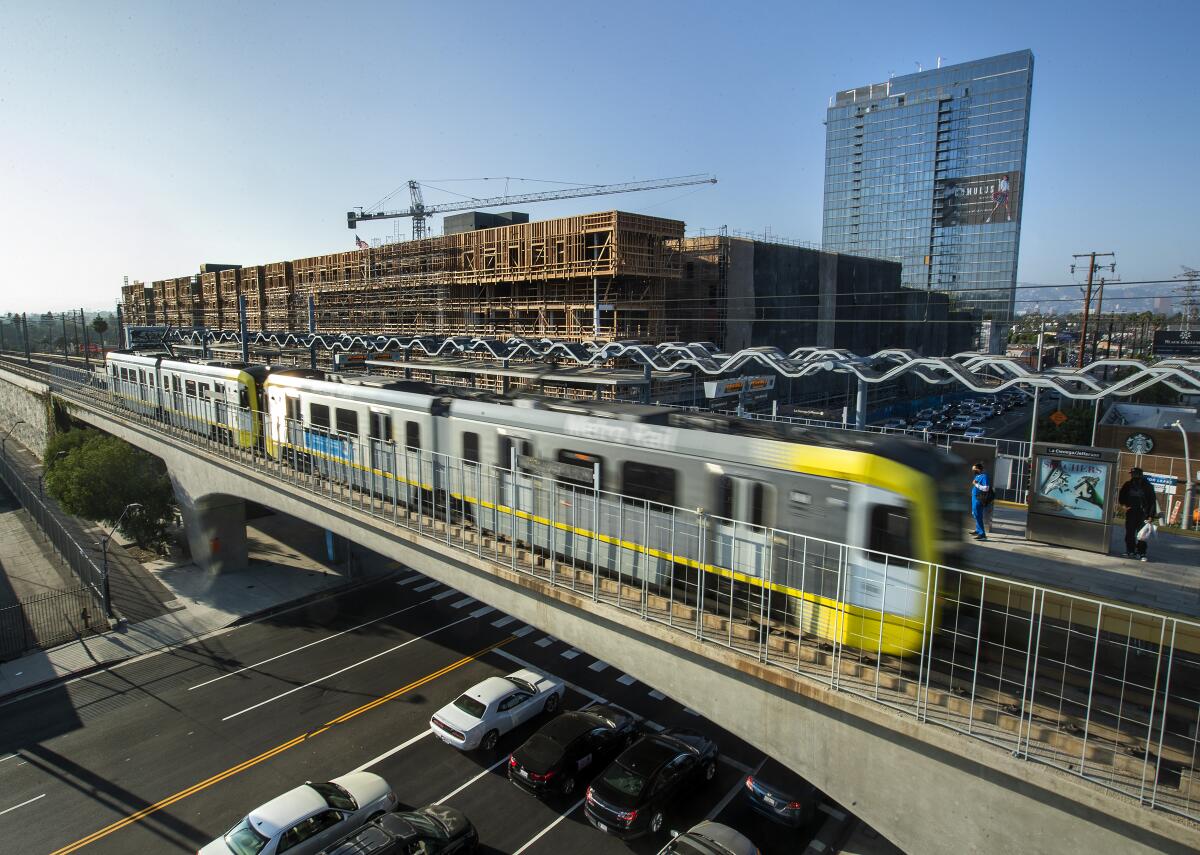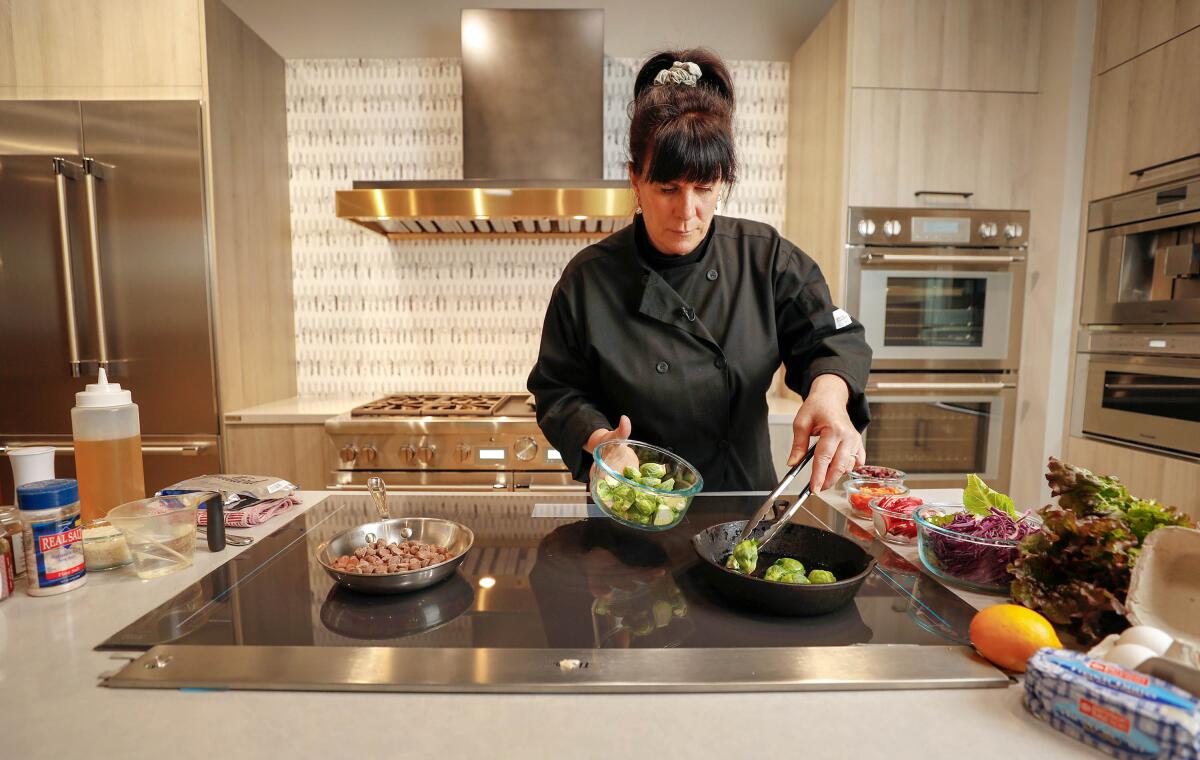Newsletter: If a sprawling suburb ditches natural gas, is it good for the climate?
This is the Dec. 23, 2021, edition of Boiling Point, a weekly newsletter about climate change and the environment in California and the American West. Sign up here to get it in your inbox.
Six years ago yesterday, Boots & Coots — a subsidiary of Halliburton, the oil services giant and Iraq war contractor previously led by Dick Cheney — tried one last time to stop a massive gas leak at the Aliso Canyon storage field north of Los Angeles.
But like the company’s five earlier well-kill attempts, this one failed. Halliburton was unable to do the job that Southern California Gas Co. hired it to do. The Aliso Canyon blowout lasted nearly four months, becoming an unprecedented climate disaster.
What went wrong, exactly? I tried to answer that question in a new story this week, focused on Halliburton’s claim that key evidence can’t be examined by California investigators because it was only ever stored on a single laptop computer — and that computer was stolen from an employee’s truck in a Best Buy parking lot. The state’s Public Advocates Office is skeptical.
Aliso Canyon is just one part of an extensive network of pipelines, compressor stations and storage fields that are used by utilities such as SoCalGas to sell natural gas for space heating, water heating, cooking and electricity generation. It’s a network that many climate advocates are trying to eliminate, or at least begin phasing out — with growing amounts of success.
For evidence of that success, check out this excellent story by my colleague Evan Halper, which is currently available exclusively to L.A. Times subscribers. Evan writes that more than 50 California cities have banned or restricted natural gas hookups in new homes and businesses, and that the movement is spreading to other parts of the country, including New York City.
Evan also watches a chef demonstrate the use a gas-free induction cooktop. He concludes that it “could be a game changer.”
“Induction cooking threatens to undermine the strongest case the natural gas industry has for keeping pipelines flowing into homes and businesses. And the technology keeps improving,” Evan says in a video embedded in the story.
All of which brings me to this week’s topic of discussion: Tejon Ranch.
If you’ve ever driven north from Southern California on Interstate 5, that name may ring a bell. It’s a huge expanse of mostly undeveloped private property straddling Los Angeles and Kern counties. At 270,000 acres, it’s nearly the size of the city of L.A.
The landowner, Tejon Ranch Co., plans to build 19,333 homes as part of a sprawling residential and commercial development known as Centennial — and as my colleague Louis Sahagún reported this month, none of those homes will have gas hookups.
The developer didn’t just wake up one day and decide to ditch gas. A judge blocked construction in April, ruling that Centennial’s environmental review was inadequate on several fronts. Tejon Ranch entered negotiations with Climate Resolve, the nonprofit that had successfully brought suit, and ultimately reached a settlement agreement. As part of that agreement, Tejon Ranch pledged there will be no gas hookups in homes at Centennial, or at a separate residential development it plans to build in Kern County.
That means those homes will have electric heat pumps for heating and cooling and induction stoves for cooking, at least initially.
“It’s fantastic,” said Panama Bartholomy, director of the Building Decarbonization Coalition, an advocacy group that wasn’t involved in the settlement negotiations. “And it is just the kind of development we’re going to see as standard moving forward here in California, really quickly. It’s what we need to meet our clean energy and climate goals.”
For a long time, the criticism of electric appliances was that they cost more than gas, and could raise housing prices in a state that’s already way too expensive. But the technology is getting cheaper — and not installing gas lines can save money too.
“We think that, down the line, what we will save in infrastructure development by not having to put in all the gas infrastructure and the hookups will offset the cost of going to the all-electric,” Tejon Ranch spokesperson Barry Zoeller told me.
So: Big win for climate, right?
It depends on whom you ask.
When I tweeted about the settlement, I was inundated with responses suggesting Tejon Ranch’s master-planned community would still be terrible for the climate because it’s a poster child for suburban sprawl that forces people to spend ever-more time driving their cars, commuting from home to work or wherever else. Transportation is by far the biggest source of climate pollution in California, responsible for nearly 40% of the state’s carbon emissions — about four times as much as gas heating and cooking.
The environmental impact report for Centennial estimated it would generate 77,000 vehicle trips outside the project site each day. Those trips would spew 77,000 metric tons of carbon dioxide into the atmosphere each year — three times as much carbon as would have been produced by the community’s natural gas appliances if Tejon Ranch hadn’t agreed to forgo gas hookups.
That’s one of the main reasons some climate activists oppose Centennial. They say as much as California needs more housing, the only sustainable solution to the state’s housing crisis is density: building more apartments and other residences in areas that are already well populated and well served by public transit. That way people can get around more easily without driving.

I asked Bryn Lindblad, deputy director of Climate Resolve, why her group had negotiated with Tejon Ranch rather than try to get Centennial’s approval thrown out in court. She told me Climate Resolve saw this as a game-changing opportunity to show the home-building industry that net-zero emissions — the standard Tejon Ranch has now agreed to meet — is feasible.
“We’re very interested in developing policies that change that calculus for the development industry,” Lindblad said.
It’s also possible that, even after the judge’s unfavorable ruling, Tejon Ranch could have worked with L.A. County to revise the project’s environmental report to the judge’s liking, and gone ahead with construction with no further climate concessions.
There’s an intriguing math question here too. The environmental report projected Centennial would generate more than 150,000 metric tons of carbon pollution each year. Critics said that number was a gross underestimate — and as part of the settlement with Climate Resolve, Tejon Ranch agreed to set a much higher number as the baseline from which they must cut.
The company now acknowledges that without the newly agreed-upon efforts to reduce emissions, Centennial would generate 500,000 tons of carbon — triple the original estimate. About three-quarters of that pollution would come from cars and trucks.
So with half a million tons of carbon to deal with, how does Tejon Ranch plan to achieve net-zero emissions?
Using electric heat pumps instead of gas furnaces will play a role, as will electric cars. Tejon Ranch will offer an inflation-adjusted $5,000 incentive to any home buyer or renter who purchases an electric vehicle, for as many as half of the families that live at Centennial — a deal that could cost the developer $48 million. The company will install an EV charger at every home, plus many more in and around the community and throughout Southern California, including 5,000 in heavily polluted low-income areas.
Other steps laid out in the settlement agreement include $7,500 incentives for companies to buy electric trucks, $8 million to support electric school and transit buses and vans, and a 100% clean electricity requirement for the development.
Zoeller also made the case that Centennial won’t generate nearly as many long commutes to and from L.A. — or Bakersfield — as critics fear. He said the development will have a strong commercial component, creating an estimated 23,000 jobs on site.
“Centennial is not this suburban, commuter-type community,” the Tejon Ranch spokesperson told me.
The project’s critics are highly skeptical of that claim, to say the least.
Let’s get back to the math, though. Tejon Ranch acknowledges its project would generate 500,000 metric tons of carbon pollution — but it’s promising to eliminate only half those emissions through steps such as ditching gas and paying residents to buy electric cars. To “mitigate” the other half, the developer can fund off-site projects that reduce pollution, known as offsets.
Carbon offsets don’t have the greatest reputation — especially offsets meant to keep carbon out of the atmosphere by preventing deforestation. Reporters at Bloomberg, Inside Climate News and the L.A. Times have documented many flaws in these programs.
I asked Danny Cullenward, a leading offsets researcher and policy director at the nonprofit CarbonPlan, to take a look at the Tejon Ranch settlement. He told me it gives the developer access to “the vast majority of the private offsets market” — which means, in his view, there’s little guarantee that any of the projects Tejon Ranch funds will make a real difference to the climate.
When I ran that criticism past Climate Resolve’s Lindblad, she told me the settlement will push Tejon Ranch to invest specifically in “new projects that reduce emissions.” It also requires Tejon Ranch to use offsets only as a “last resort” when it’s unable to reduce emissions on site — and only then with the approval of a monitoring group formed by Climate Resolve and the developer.
So at the end of the day, what have we got here? Tejon Ranch plans to build 19,333 new homes in a state that badly needs more housing, including 3,480 affordable units — while generating up to quarter-million metric tons of climate pollution annually. That’s as much carbon as was produced last year by the controversial gas-fired power plant in Redondo Beach.
Bartholomy is thrilled Centennial is going gas-free — he doesn’t know of any other home development this big being built all-electric. But when I asked him about suburban sprawl and all those car trips, he readily acknowledged the problems.
“We haven’t coordinated our housing and our climate policies, and Tejon Ranch is a perfect example of that,” he said. “Electrification is great... But not all future growth is in alignment with our climate policies, or our water realities.”
For more reporting on the shift away from gas — and how SoCalGas is responding — scroll to the bottom of this newsletter.
But first, here’s what else is happening around the West:
TOP STORIES

“It’s like the gates of hell have been opened.” My colleagues Susanne Rust and Carolyn Cole traveled to Alaska to learn about dramatic changes upending some of the world’s most important fisheries as ice melts and the ocean heats up — and why those of us who don’t live in the Arctic should care. Fish and birds are dying en masse, in what scientists describe as less of an ecosystem collapse and more of a “regime shift” with winners and losers. The losers include Pacific cod, Alaska pollock and possibly gray whales, which migrate between Baja and the Arctic and are in steep decline, as Susanne and Carolyn detailed in an earlier story.
The Biden administration approved two huge solar farms in the California desert — a reminder that it still has tools to combat the climate crisis, even with the president’s Build Back Better legislation blocked. Here’s my story on the solar farms, which also offer a reminder that the clean energy transition comes with its own environmental challenges. And here’s the latest from my colleague Eli Stokols and Chris Megerian on how congressional Democrats and climate activists are responding to West Virginia Sen. Joe Manchin III’s announcement that he won’t support Biden’s far-reaching climate bill. Manchin, as you might recall, has gotten rich from his family’s coal business. He says he’s got no conflict of interest because of a blind trust — but the trust doesn’t cover nearly all of his income from coal, as the Washington Post’s Michael Kranish and Anna Phillips discovered.
The Smith River is California’s last major free-flowing waterway, with no dams. But that doesn’t mean the watershed is in pristine condition — and when ranchland by the river mouth went up for sale, chaos ensued as conservationists scrambled to shape its future. So writes The Times’ Rosanna Xia in a gorgeous story with photos by Allen J. Schaben. “This collision of interests now coming to a head at Reservation Ranch strikes at the heart of an uncomfortable truth: California, like the great American West, was largely built on violence — violence to not just the land, but also the native people of the land,” Rosanna writes.
THE ENERGY TRANSITION

Even though I wrote thousands of words about rooftop solar last week, there was at least one aspect of the net metering debate I didn’t cover: the avoided cost calculator. Fortunately, Canary Media’s Jeff St. John explained how it works and why it matters. And in a reminder of one reason why many clean energy advocates prefer rooftop solar to large solar farms connected to cities by long-distance power lines, my colleague Hayley Smith reports that state officials reached a $550-million settlement with Southern California Edison over five wildfires ignited by the company’s power lines, including the Thomas and Woolsey fires.
The battery boom is pretty crazy right now. The Wall Street Journal’s Jennifer Hiller and Katherine Blunt report that the U.S. is on pace to add 6 gigawatts of large battery installations to the power grid this year — up from less than 1 gigawatt last year. Analysts expect an additional 9 gigawatts of batteries to come online next year, mostly of the four-hour, lithium-ion variety. Not all types of energy storage are seeing this kind of success, though. The San Bernardino Sun’s Joe Nelson reports that federal officials have once again rejected a pumped storage project proposed for Lake Elsinore in California’s Riverside County.
Carbon monoxide poisoning caused by portable generators has killed at least 1,300 people in the U.S. over the last two decades. More people are using these generators to keep the lights on and stay safe as climate-fueled extreme weather leads to a growing number of power outages, but the industry has managed to stave off federal safety rules that experts say would make their products less dangerous. That’s the key finding of a horrifying investigation by the Texas Tribune, NBC News and ProPublica.
POLITICAL CLIMATE
I wrote recently about the small number of renewable energy projects the Biden administration has approved on public lands. The two solar farms I mentioned earlier add to the total, but there’s also this: The Fallon Paiute-Shoshone Tribe and Center for Biological Diversity are suing to block a geothermal plant approved by Biden appointees, saying it would dry up a Nevada spring that sustains the Dixie Valley toad and degrade spiritually significant land. More details here from Reuters’ Sebastien Malo.
The Environmental Protection Agency finalized new rules to reduce climate pollution from cars and light trucks. But even though the tailpipe rules are stricter than the Biden administration originally proposed, they’re still slightly weaker than what the Obama administration tried to implement years ago, according to the Washington Post’s Dino Grandoni, Faiz Siddiqui and Anna Phillips. In other news, the International Energy Agency says global SUV sales will hit an all-time high this year — not great!
The Federal Energy Regulatory Commission will consider new rules to make sure utilities aren’t charging their customers for trade association dues that are then used for lobbying and other political activities. Here’s the story from Utility Dive’s Ethan Howland. I wrote in May about the Center for Biological Diversity asking the federal commission to take up this issue.
AROUND THE WEST

The federal government plans to air-drop poison onto the Farallon Islands off San Francisco to kill mice that are indirectly harming a bird called the ashy storm petrel. Yes, this story is as weird as it sounds; before the decision was final, Times columnist Steve Lopez wrote that some conservationists think air-dropping poison is a good idea. Here’s Steve’s follow-up column after the California Coastal Commission voted to approve the plan. If that’s not enough wildlife news for you, Lila Seidman reported on three bizarre-looking Pacific footballfish — yes, that is their real name— that washed up dead in California this year.
Utah’s super-powerful “Prep 60” lobby has persuaded lawmakers to endorse billions of dollars for water supply projects while largely ignoring conservation, even though that’s much cheaper. That’s the conclusion reached by ProPublica’s Mark Olalde in this fascinating investigation into the halls of power in America’s fastest-growing, second-driest state. I also enjoyed this piece by the San Diego Union-Tribune’s Joshua Emerson Smith about San Diego County, which has a different problem: Water conservation has been so successful that water rates are rising dramatically, in part to cover the costs of desalination and imports.
A lawsuit filed by California’s attorney general alleges Walmart is dumping nearly 80 tons of hazardous waste in landfills each year. Here’s the story from my colleague Hugo Martín; Walmart denies any wrongdoing. Also this week, more than 1,300 gallons of gasoline from a 76 station in Pasadena flowed into a tributary of the Rio Hondo River after a vehicle collided with a pump, The Times’ Laura Newberry reports. Local residents were advised to stay indoors and close all windows. Meanwhile, an oil sheen the size of a football field was spotted off the Pacific Coast near the site of a recent offshore spill, Hannah Fry reports.
A FEW MORE THINGS

Returning to our discussion from earlier, there’s little question electrification is moving full steam ahead.
Just last week, the California Building Standards Commission approved a new building code that makes electric heat pumps the baseline for compliance — not quite a ban on gas in new construction, but a policy likely to prompt some builders to go all-electric. The new rules also require stronger ventilation for kitchens with gas stoves, in an effort to protect people from indoor air pollution.
The state’s Public Utilities Commission, meanwhile, has proposed ending a practice in which gas utility ratepayers — i.e. customers of SoCalGas, Pacific Gas & Electric and San Diego Gas & Electric — cover some of the costs of extending gas lines to new homes.
And it’s not just government: Southern California Edison announced this week it’s seeking permission to spend $677 million in ratepayer money incentivizing people to ditch gas, with a goal of getting 250,000 customers to install electric heat pumps.
It’s been almost three years since I wrote that Edison and SoCalGas were headed for a confrontation, with the utilities promoting competing visions for the Golden State. When I asked SoCalGas about Edison’s new proposal, I was told by spokesperson Christine Detz that “we look forward to reviewing that and offering feedback through the established [utilities commission] process.”
But consider this: In October, SoCalGas released a report laying out four visions of how the state might achieve net-zero climate pollution by 2045. In one scenario, almost every sector of the economy goes fully electric — a vision the company unsurprisingly rejected as too expensive and too vulnerable to power outages on the electric grid. But in the other three, between 50% and 95% of buildings eventually use electric space and water heating — and SoCalGas suggested all three scenarios are reasonable.
That could mean a lot less business for SoCalGas providing natural gas to homes. But the company sees a significant role for itself supplying cleaner fuels such as green hydrogen and biomethane to power plants that can fire up when the sun goes down, and to heavy-duty trucking and industries that are expensive to electrify. As SoCalGas Chief Executive Scott Drury wrote in an op-ed for CalMatters, “The electric and gas systems aren’t competitors. Instead, they complement each other’s strengths.”
None of that means the nation’s largest gas utility is embracing a future in which its shareholders make less money.
But in a sign that SoCalGas sees its business potentially shifting away from residential customers, the company joined with PG&E and SDG&E this week to say it doesn’t oppose ending ratepayer subsidies for gas line extensions to new homes. The gas utilities did, however, object to eliminating those subsidies for new gas lines to non-residential customers, saying ratepayers should continue to pay for projects “that provide environmental or financial benefits” — such as supplying hydrogen or biomethane.
There’s still plenty of controversy surrounding those fuels. But the writing is on the wall that fossil gas is on the way out.
Attitudes toward SoCalGas are changing, too. When I wrote about the company’s efforts to drum up opposition to all-electric buildings back in 2019, I discovered that Climate Resolve — the group that negotiated the Tejon Ranch settlement — had honored a SoCalGas executive for his work on climate, after accepting $86,500 in gas company funding over the previous four years.
But since then, Climate Resolve has adopted a policy of not taking money from SoCalGas.
“We didn’t want any misconceptions conflating the intake of SoCalGas money to be perceived as a false indication that we were in support of a prolonged natural gas industry,” Lindblad said in an email.
That’s the third environmental nonprofit to tell me it’s stopped accepting SoCalGas funding, following Pacoima Beautiful and Heal the Bay. I wouldn’t call that an overwhelming trend. But it’s certainly an intriguing data point in a storyline full of them.
We’ll be back in your inbox next week. If you enjoyed this newsletter, please consider forwarding it to your friends and colleagues.
For the record: Last week’s edition said new monthly utility bill fees proposed by the California Public Utilities Commission would be “a bit less” for low-income homes that install solar panels, “except in San Diego.” The fees would actually be substantially less if not nonexistent for low-income homes, including in San Diego.




